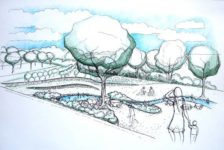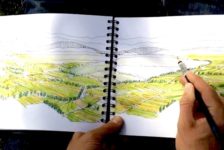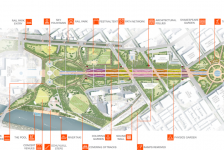“To engage with potential digital technologies is to understand a new language, new workflows, design processes and theory.” Landscape Architecture and Digital Technologies: Re-Conceptualising Design and Making is a glimpse behind the scenes into some of the today’s most cutting-edge design firms and a welcome, in-depth exploration of the tools that are shaping their most unique landscapes. The range of programs and techniques used to develop projects has been changing at a breakneck pace over the last decade. While most firms have reached proficiency with computer aided drafting and perhaps delved into 3D modeling, many designers might be surprised by the breadth of methods presented in this book.
Form is often a direct representation of the tools used to derive it. These days that means many, if not most, of the landscapes you create are done in plan and with CAD lines. The result can be great, but sometimes it can also lack significant considerations beyond form. Digital Technologies, by Australian landscape architects Jillian Walliss and Heike Rahmann, explores the means and methods leading firms utilize to create complex, high-profile projects. The authors break down design processes and then focuses on the tools employed to create structures, predict performance, simulate nature, and collaborate with others.
 Diana, Princess of Wales Memorial Fountain by Gustafson Porter
Diana, Princess of Wales Memorial Fountain by Gustafson Porter
In writing this review, it would be remiss not to mention the excellent review of the same book recently published in Landscape Architecture Magazine by Gale Fulton, the Director of Landscape Architecture at the University of Tennessee. The unique aspect of his take on Digital Technologies is that he sees the perspective of students who rotate through his halls annually. He highlights the interesting backlash against digital that is an almost nostalgic trend towards sketching and allure of the “authentic.” He also references a 2013 survey by the ASLA that reported the belief that “technology negatively influences creativity” and that design requires “human creativity” and “human spontaneity.”
I believe that, on a certain level, this criticism is warranted in the fact that digital tools have been largely leveraged for representational imagery. Designers, under pressure from an escalating war of visual expectations, have to exert more and more time for education and production to create quality digital images. Firm principals have to then leverage more of their budget to create more refined products earlier in the process. These obstacles and sentiments can result in the what Fulton called the “slow advance of the digital in landscape architecture.” Across the industry, landscape architecture is clearly lagging behind architecture in utilizing advanced tools for more than just renderings. Digital Technologies aims to present real-world examples of how these tools can play a prominent role in a project from concept to implementation.
Digital Technologies highlights projects from the following firms, amongst others:
- Snøhetta (Norway + USA)
- Arup (England + Worldwide)
- Gustafson Porter (England)
- ASPECT Studios (Australia)
- Grant Associates (England)
- Catherine Mosbach (France)
- Philippe Rahm (Switzerland)
- PARKKIM (South Korea)
- LAAC (Austria)
- PEG (USA)
Topographic Surface
One of the distinct advantages of the new age of digital documentation is the ability to model complex geometries and landforms based on improved survey information. However, beyond just making a simple model out of contour lines, many landscape architects haven’t been able to take the next steps in creating complex forms for themselves in high detail. The book explores the concepts of form generation and how some firms are using techniques like parametric modeling and scripting.
Thermal City by PARKKIM
Performative Systems
Perhaps one of the most recognizable projects that places performance at the forefront of design is Fresh Kills Park by James Corner Field Operations. Building on this example, Digital Technologies focuses on the shift toward more quantifiable systems in design. One of the biggest components of this movement is parametric modeling. The book “frames parametric modeling as a speculative research process where form emerges through the interrogation of information, and performance.” The result of this being that designers “model behaviors and relationships of systems, phenomena, and form and seek to establish a set of rules to apply within further design approaches.” This observation becomes increasingly more poignant in the face of more available data, especially that on the effects of climate change.
Simulating Systems
Increasingly, available software capable of modeling the fluid dynamics of wind, water, tides, heat, humidity, and pollution present new opportunities for embedding temporality and change into design processes. Digital Technologies highlights the Supertrees at the Gardens by the Bay in Singapore by Grant Associates, Thermal City by PARKKIM, and Sigirino Alptransit Depot by Atelier Girot. The book makes the case that simulating systems is a missing link between a design and a “finished” product that is years, maybe decades, down the road.
Sigirino Alptransit Depot by Atelier Girot
Materiality and Fabrication
Much of what landscape architects design is ultimately constructed from items in a catalog. Concrete from this supplier, benches from this company, or lights from this or that catalog. And while there is nothing wrong with sourcing materials from artisans who focus on creating one or a few products of high quality, emerging technology has “provided new opportunities for exploring materiality and construction techniques.” The lead example in Digital Technologies is again the Super Trees of Singapore’s Gardens by the Bay by Grant Associates. The trees were fabricated using BIM software to document designs and connections.
“The ability to translate designs directly from 3D digital systems into physical installation without spending on 2D abstraction, so called ‘file to fabrication,’ opens new avenues for more efficient automated production processes.” The seamlessness between design and fabrication also encourages more prototyping which should lead to more effective and thoughtful designs. This process, however, relies on many people with a highly specialized skill sets – often those not directly related to landscape architecture. The future of the profession may see us relying more and more on these experts, which begs the question, how can we collaborate with others more effectively?
Collaboration
Much has been said about the advantage of BIM software, like Autodesk’s Revit or Vectorworks Landmark, in documenting the entirety of a project in 3D. While there are still shortcomings in the way landscapes can be modeled, one of the biggest benefits to its implementation is more unencumbered collaboration. When teams can see changes to a site quicker, they can react and work more efficiently. Cooperative design with consultants that may be located all over the world is more and more common in this digital age. Beyond meetings, designers need to see how their decisions are reflected in the work of other trades. That being said, Digital Technologies is quick to point out that there are deficiencies to current BIM integration. The authors warn of reduced design development down to “the assemblage of objects provided by the software toolbox – adding a further bureaucratic layer to design.” BIM also makes designers ultimately rethink their role entirely. Traditionally, architects have become more and removed from construction. Better integration may allow us to patch that gap moving forward.
The Future
Digital Technologies predicts the power of the digital model, continually evolving education, transformation of practices, and a greater focus on research will all have a big impact on the profession in the years to come. Many firms are also placing a bigger emphasis on research as a fundamental aspect of their practice. I believe that we are on the verge of a major shift in the way that landscape architects design and document projects. The transformation to modeling and BIM related systems is undeniable. Can we, however, maintain, the soul of our designs while moving into this new methodology? Only time will tell.
—
Benjamin Boyd is a landscape architect practicing in Baltimore, Maryland. Check out his profile on Goodreads to see what he has been reading. Ben often tweets about landscape at @_benboyd.

















Tim Calnan
A good review of Landscape Architecture and Digital Technologies.
Gale Fulton’s reference to the 2013 ASLA survey reflecting the belief that “technology negatively influences creativity” is sad to continue to hear 30 years after the CAD revolution and particularly if this sentiment is a genuine reflection of perception of students… the future generation tasked with taking the profession into the new fully collaborative 3D modelling environment. My suggestion is that the sentiment is probably more likely to emanate from seasoned practitioners and those on the teaching staff who are outside of their comfort zone with new technologies, particularly at a time when the rate of change is occurring exponentially?
The importance of ‘simulating systems’ to provide a link between ‘a design’ and the ‘finished product’ being years or decades down the road is poignant. But is this time delay due to the technology not being in place or the inability for professionals to take advantage of the technologies that are now becoming available?
There is no doubt that the tools and levels of sophistication have considerable scope for improvement to provide the performance, simulation, materiality and fabrication outcomes required for landscape… but software developers will only provide these with a fuller engagement from the profession… and a handful of good landscape techno-geeks!
Tim Calnan CMLI – CS Design Software – LinkedIn – Twitter